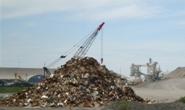Scrap Prices North America

October Scrap Forecast to be Down $10 Per Gross Ton
Written by John Packard
September 29, 2013
This week the domestic steel mills and their scrap suppliers will be locked in negotiations to determine the price of ferrous scrap used in the EAF’s and BOF’s to make steel. Steel Market Update sources have been advising that the October scrap market looks to be down $10 per gross ton before firming later in the month.
The reasons for the drop in scrap pricing is due to an expected decline in purchases due to maintenance schedules and production downtime at several mills. This includes the blast furnace taken down at ArcelorMittal Cleveland and reduction in scrap purchases at Nucor Berkeley and one or two other Nucor facilities due to maintenance and expansion projects. The U.S. has also seen a slowdown in exports of scrap off the east coast.
In Canada, USS Lake Erie Works is expected to come back online and ArcelorMittal Dofasco is reported to be expanding their scrap purchases this month. However, there is plenty of scrap in Canada and these two mills increasing their buys should not impact the U.S. market.
Mike Marley, scrap guru for Metal Prices, reported in his most recent article, “Several mills have stopped allowing their scrap suppliers to ship more than they bought as was the case this summer in some regions.” The mills generally stop shipments or prohibit the yards from over-shipping scrap when the mills believe prices will go down in the coming month.
Most of the dealers SMU has communicated with believe prices will drop in October by $10 per gross ton or less. However, one Northeast dealer told us he was more bearish and felt shred and busheling could be down as much as $15 with cut grades down $10 and turnings down $5 per gross ton.
Another dealer with whom we communicated over the weekend provided SMU with the following insights on the scrap markets:
“I tend to think October is the bottom in scrap prices as well. Over the last several years, October has been a down month in line with weaker seasonal steel demand. So it’s not surprising that this year is the same. Add in some mill outages and resulting less scrap demand and you have another artificial factor to drive prices down in the near term. But both of these factors are temporary and there is not an abundance of scrap in the market once outages are finished and the mills start increasing production into the winter.
If enough dealers realize October is the bottom and the market chatter is down $10/GT (query who exactly are the ones doing the talking however), it’s possible we will see it down less – sort of like we saw in June. Scrap flows have been ok but certainly not lighting the world on fire. If we lower prices too much as we get closer to winter, I imagine that dealers who can will hold back at least some scrap.
Export remains weak but I think if you look back over the last several years that is a seasonal pattern as well. I would expect export prices both at the docks and CIF Turkey to bottom close to their current levels, maybe a little bit lower but not significantly.
Re the Nucor DRI issues, the longer the plant stays offline, the better it is for scrap. Once it comes on, Busheling values will drop, but by how much remains to be seen. The idea if cheap DRI is obviously not a good omen for scrap but there are other factors related to DRI whose effect on the prime market prices is unclear (ability to transport and store it, how much of furnace charges DRI can be, and whether the pig iron from Central America will go before prime scrap).”
Negotiations are expected to continue through the end of the week and possibly into the following week.

John Packard
Read more from John PackardLatest in Scrap Prices North America

HRC vs. scrap spread widens over $150/ton in March
The HRC vs. prime scrap spread increased again in March.

HRC vs. prime scrap spread increases in February
The price spread between hot-rolled coil (HRC) and prime scrap widened in February ahead of the implementation of President Trump’s tariffs on steel.
HRC vs. prime scrap spread narrows again in January
The price spread between hot-rolled coil (HRC) and prime scrap continued to narrow in January, according to SMU’s most recent pricing data. While SMU’s average HRC price edged down week over week (w/w), it rose compared to a month ago. The January price for busheling also increased from December. Our average HRC price as of […]

HRC vs. prime scrap spread flat in November
The price spread between hot-rolled coil (HRC) and prime scrap remained the same in November as both tags were at the levels seen a month earlier, according to SMU’s most recent pricing data.

HRC vs. busheling spread narrows slightly in October
The price spread between hot-rolled coil (HRC) and prime scrap narrowed marginally in October, according to SMU’s most recent pricing data.
